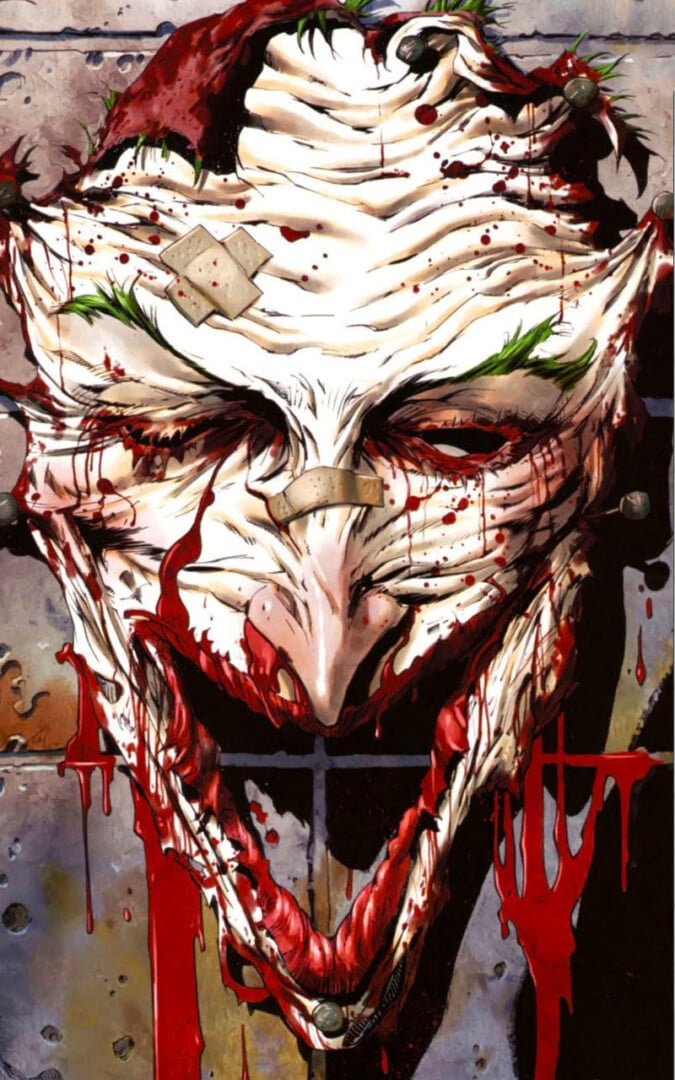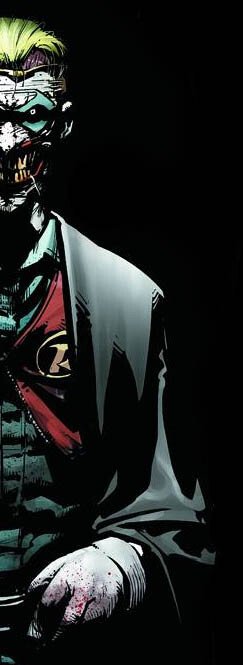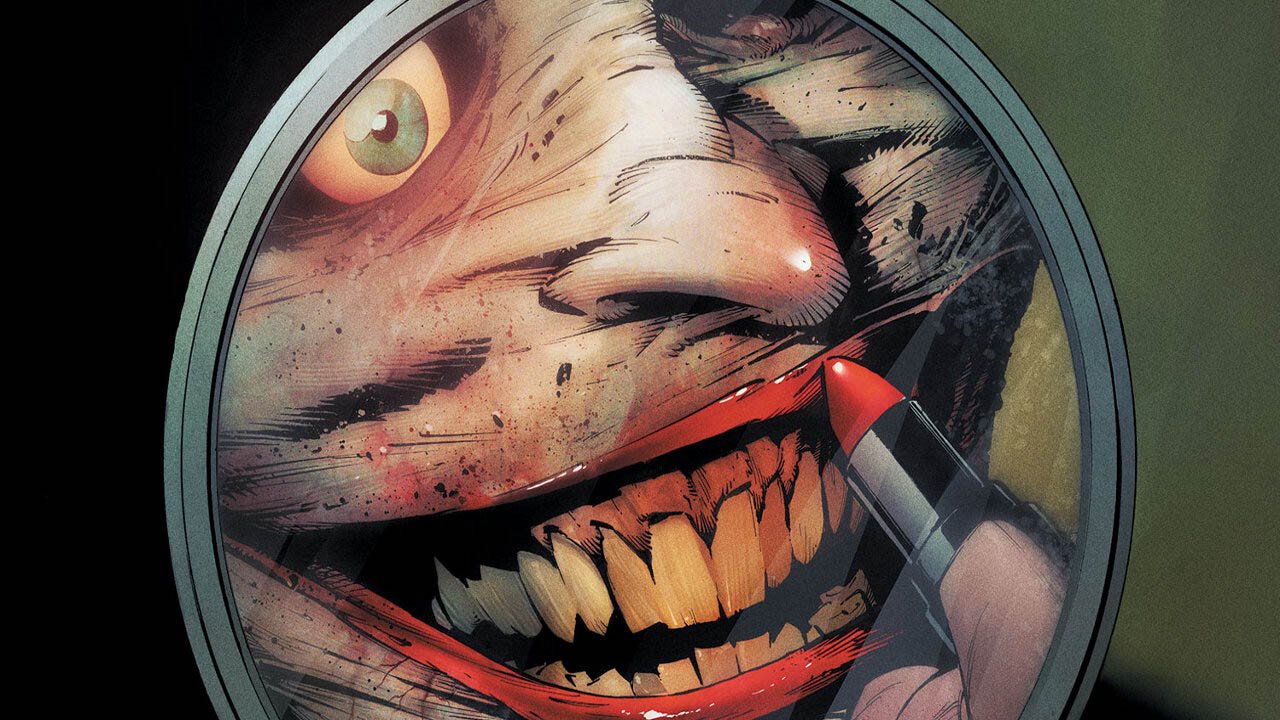Ever since he took over Batman at the start of the New 52, Scott Snyder has been putting on a Batman master class. He didn’t come out of nowhere for the run, having previously delivered the finest non-Grant Morrison-Dick Grayson-Batman story in Black Mirror (not to mention his brilliant and award-winning American Vampire series for Vertigo). However, his modern classic Batman launch series Court Of Owls announced, in no uncertain terms, that there was a new master in the batcave and that our beloved caped crusader was in good hands for the New 52. When it was revealed that Snyder would be delivering his take on the Joker after finishing his Owls run, fans were drooling in anticipation. After all, Joker had been missing from Bat-books for a year at that point, and the character was also missing his face. Thankfully, Snyder delivered. The Death Of The Family cross-franchise event might have been hit-and-miss in a way that diluted its overall impact (see last week’s review of the Joker: Death Of The Family collection for more), but now, in an isolated trade paperback, it’s clear that Snyder’s arc is one of the finest Joker stories ever conceived. I know that sounds a bit ridiculous given that it’s not even a year old, but honestly Snyder’s vicious little story is just that good.

The tale opens on one of those ominously dark n’ rainy nights where only bad things can happen. Commissioner Gordon even comments on that cliché in the opening monologue… and then all his worst fears come true. The Joker suddenly arrives at the Gotham Central, tells a few bad jokes, kills a few good cops, and leaves with his discarded face. Now sporting a clown-flavored Leatherface ensemble, Joker then starts reenacting some of his earliest crimes. Harley pops up at Ace Chemical wearing the old red hood costume claiming that her puddin’ has changed. The Gotham reservoir once again seems in danger. Then things get personal. Alfred is kidnapped. In pursuit, Batman suddenly runs into Joker on a bridge where he claims that he’s tired of the old games and has something a little more personal planned for Batman this time. He announces on a police radio that the whole Bat-family can hear that he knows every single masked avenger’s true identity, and he plans to come after them all. He does it and saves the best for last and for Batman. Reenacting another Bat-classic, he invites Batman to join him for a private party in Arkham Asylum. You see, the Joker has turned the place into a psychotic theme park dedicated to the relationship between himself and the Caped Crusader. He wants to show Batman how much he loves him and how the Joker and the rest of the rogues gallery of Bat-villains are the Bat’s real family. They make Batman stronger while Robin, Nightwing, Batgirl and the rest just make him weak. The plot is the Joker’s love letter to Batman and his punchline? Well, it’s in the title.
Batman and The Joker are of course the greatest and most popular hero/villain team in comics. Their relationship and duality has been explored so many times and in so many ways by so many great writers, artists, and filmmakers, that it can feel like there’s no more marrow to be sucked from those bones. At least, that’s how it feels until a book like Death Of The Family comes along. The Joker was booted out of the comics for a year not because the fans stopped loving him, but because it was difficult to find things to do with the character, particularly after Heath Ledger’s searing performance in The Dark Knight finally introduced the Joker known only to comic book fans to the masses. With Death Of The Family, DC and Snyder delivered a Joker story that could never be on film, if only because it would be rated a hard R. Snyder came into superhero comics after making a name for himself in horror comics. While plenty of other Bat-tales of the past have taken advantage of the franchise’s gothic potential, Snyder was one of the first writers to bring out the horror elements of Gotham City to their full potential.

He did it first in Court Of Owls and really does it to the Joker here. The central facemask image is nauseatingly terrifying, instantly replacing any of the character’s camp with full frontal monster movie psychosis. Backed by former Spawn artist Greg Capullo’s stunning visuals, Death Of The Family and its Joker are absolutely terrifying. The rotting facemask is sickening from the start (the way Capullo gradually charts the facemask’s fly-attracting decomposition over the run is gag inducing). Panels are laid out in classic film editing suspense structures that deliver big jolts. Then there’s the Joker’s plot, which involves a live flaming horse, the worst family dinner since The Texas Chainsaw Massacre, and a living portrait of Batman/Joker adventures painted onto a canvas of prisoners connected by their smiles, limbs, and innards like a human centipede. This is the type of material that could never be in a Batman movie or TV series. This is a story only the comics could tell and Snyder/Capullo revel in that freedom to create a Joker story straight out of Bruce Wayne’s nightmares. On a purely visceral level, it’s a presentation of the Joker that even makes The Killing Joke seem tame, and in an age when the most dominant image of the character in pop culture is the Heath Ledger/Chris Nolan version, it’s exactly what Batman comics needed to remain ahead of the curve.
Beyond the gore and stunning atmosphere, Snyder also crafted a viscous little tale that presents a new side of the Batman/Joker relationship. The story sees the Joker come to Batman out of love. That’s obviously a theme that’s been played in comics since Frank Miller’s The Dark Knight Returns, but Snyder has a unique take involving the Bat family. In his story, Joker claims that the sidekicks make Batman weak, but the villains make him strong. He goes so far as to even suggest that Batman always lets his villains live, not because of a moral code, but because he couldn’t live without them. At the same time, Batman is always willing to let his sidekicks face mortal danger because he secretly doesn’t love them. That’s a pretty twisted take on Batman that somehow no writer had ever touched on before and that Snyder was not only smart enough to acknowledge it, but steeped enough in Batlore to know that the Joker was the only character who would come up with the idea in Gotham. That theme gives Death Of The Family something that adds to the Bat-mythos and makes it more than simply a stunning crafted bit of horror Bat-fiction.
After Death Of The Family, it feels like the Joker has undergone yet another transformation that will flavor the character for years to come. Obviously, there’s the whole “missing face” thing that will play into continuity for at least one more storyline, but more than that, the Joker has now gone to a new level of perversion, psychosis, obsession, and love that writers have to build on from here. The story, art, and ideas hit as hard as any classic Joker yarn, and I’m confident that within a few years it won’t be possible to compile a list of The Greatest Joker Stories Ever Told without including Snyder’s effort. It’s also arguably the tightest and most successful Batman story that Snyder has written to date. Court Of Owls petered out a bit towards they end thanks to an overambitious tie-in climax and a questionable plot twist. Black Mirror was great but as a Dick Grayson/Batman story, it’ll always be a second-run arc. Death Of The Family is exciting to read issue-by-issue, fascinating to examine as a collected work, and features some of the finest and most unsettling art Gregg Capullo has ever created.

Death Of The Family is a little Batman masterpiece, and it only makes sense that Snyder’s finest Batman story would be a Joker tale. After all, a hero is only as strong as his villain, and there’s a case to be made that the Joker is the most fascinating and iconic villain in pop culture. Thank God Snyder will be on Batman for the foreseeable future because he only seems to be getting better at writing this universe and diving deeper in his examination of the mythology with every arc. He’s even promised one more Joker storyline before he leaves Gotham behind. He’s said that Death Of The Family was his Joker story rooted in a love for Batman. The follow up will see the Joker driven by hate. Given how terrifying the love story was, I’m almost scared to read the next one. Obviously, I will though. As good at Snyder is at writing Batman, he’s even better at feeding the Joker’s madness.
Notes on the trade: The brass at DC are clearly as gushy about Death Of The Family as I am and delivered a gorgeous hardcover collection. Capullo’s art has never looked better than on these glossy pages, filled with nightmarish details a monthly printing just can’t provide. The cover is also wonderful. A clear plastic slip over has the Joker’s skin mask as was featured on the first issue of every Death Of The Family arc. However, when you pull the face back on the trade you won’t see a Bat family member underneath, but the Joker’s skinless, scarred face stuck in a rictus grin. It’s a pretty grisly drawing from Capullo and one hell of a cover. It should also be noted that Snyder has actually changed some dialogue from the original printings for the trade. It’s only a few scenes and mostly in the final issue, but hard to miss if you’re looking for it. Essentially, Snyder rewrote some dialogue to make the Joker’s message and the theme of the book more obvious. The new material does clear up some ambiguities, and it reads better as a standalone story as a result. Yet a few pointed exchanges between Bats and the clown are missing from the original printing that I wish were included here somewhere (particularly when Batman maliciously calls his foe “darling”). However, it is an overall improvement and Snyder was right to do it. It just means that completists might want to hang on to their original issues rather than selling them off for the trade.





